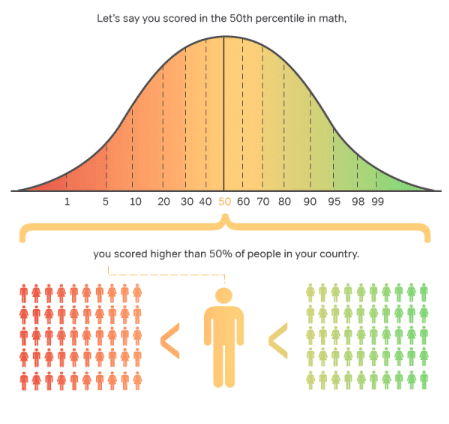
Your ACT percentile ranking tells you how you did compared to everyone else on the ACT test. ACT percentiles are, in some ways, even more important than your actual ACT score. Why? Because they provide an easy way to compare your performance on the ACT to other test-takers overall, providing you with important information for your ACT prep.
Read on for everything you need to know about ACT score percentiles.
How Are ACT Score Percentiles Calculated?
ACT percentiles are calculated by comparing one ACT score to the distribution of scores of all the students who took the ACT at a given time. On your ACT score report, the lowest percentile possible is the 1st percentile and the top percentile is the 99th percentile (it’s impossible to score at the 100th percentile because that would mean that your ACT score is higher than your score, which makes no sense!).
As a standardized test, the ACT is intentionally designed to get most students scoring at the 50th percentile mark. The following infographic might help you visualize the ACT score distribution:

ACT scores and their corresponding percentiles tend to stay the same year to year. So, for example, scoring a 32+ typically means you did better than 97% of test-takers and scoring a 26 typically means that you did better than 82% of test-takers. (Note that these scores don’t mean that you scored a 97% or a 82%, respectively, on the test.)
To see for yourself how the relationship between ACT scores and their percentiles don’t change much, click here to see the ACT percentiles by year for composite scores over the last 10 years:
Historical ACT Composite Score Percentiles
| ACT Composite Score | 2024 | 2023 | 2022 | 2021 | 2020 | 2019 | 2018 | 2017 | 2016 | 2015 | 2014 | ACT Composite Score |
|---|---|---|---|---|---|---|---|---|---|---|---|---|
| 36 | 100 | 100 | 100 | 100 | 100* | 100 | 100 | 100 | 100 | 100 | 100 | 36 |
| 35 | 99 | 99 | 99 | 99 | 99 | 99 | 99 | 99 | 99 | 100 | 100 | 35 |
| 34 | 99 | 99 | 99 | 99 | 99 | 99 | 99 | 99 | 99 | 99 | 100 | 34 |
| 33 | 98 | 98 | 98 | 98 | 98 | 98 | 98 | 98 | 98 | 99 | 99 | 33 |
| 32 | 97 | 97 | 97 | 96 | 96 | 97 | 96 | 97 | 97 | 97 | 98 | 32 |
| 31 | 96 | 95 | 96 | 95 | 95 | 95 | 95 | 95 | 96 | 96 | 96 | 31 |
| 30 | 94 | 94 | 94 | 93 | 93 | 93 | 93 | 93 | 94 | 94 | 95 | 30 |
| 29 | 93 | 92 | 93 | 90 | 90 | 91 | 91 | 91 | 92 | 92 | 92 | 29 |
| 28 | 91 | 90 | 90 | 88 | 88 | 88 | 88 | 88 | 89 | 89 | 90 | 28 |
| 27 | 88 | 87 | 88 | 85 | 85 | 85 | 85 | 85 | 86 | 86 | 87 | 27 |
| 26 | 86 | 85 | 85 | 82 | 82 | 82 | 82 | 82 | 83 | 82 | 83 | 26 |
| 25 | 83 | 81 | 81 | 78 | 78 | 78 | 78 | 78 | 79 | 78 | 79 | 25 |
| 24 | 79 | 78 | 77 | 74 | 74 | 74 | 74 | 73 | 74 | 73 | 74 | 24 |
| 23 | 75 | 74 | 72 | 70 | 70 | 69 | 69 | 68 | 69 | 68 | 68 | 23 |
| 22 | 71 | 69 | 68 | 64 | 64 | 64 | 64 | 63 | 64 | 62 | 62 | 22 |
| 21 | 66 | 64 | 63 | 59 | 59 | 58 | 58 | 57 | 58 | 56 | 56 | 21 |
| 20 | 61 | 59 | 57 | 53 | 53 | 52 | 52 | 51 | 51 | 50 | 50 | 20 |
| 19 | 55 | 53 | 51 | 47 | 47 | 46 | 46 | 44 | 45 | 43 | 43 | 19 |
| 18 | 49 | 47 | 45 | 41 | 41 | 40 | 40 | 38 | 39 | 37 | 36 | 18 |
| 17 | 43 | 41 | 37 | 35 | 35 | 33 | 34 | 31 | 32 | 30 | 30 | 17 |
| 16 | 37 | 35 | 29 | 28 | 28 | 27 | 27 | 25 | 26 | 24 | 24 | 16 |
| 15 | 30 | 28 | 21 | 22 | 22 | 20 | 21 | 19 | 19 | 18 | 18 | 15 |
| 14 | 23 | 22 | 13 | 16 | 16 | 14 | 15 | 13 | 14 | 12 | 12 | 14 |
| 13 | 16 | 14 | 7 | 10 | 10 | 9 | 9 | 7 | 8 | 7 | 7 | 13 |
| 12 | 8 | 8 | 3 | 5 | 5 | 4 | 4 | 3 | 4 | 3 | 4 | 12 |
| 11 | 3 | 3 | 1 | 2 | 2 | 1 | 1 | 1 | 2 | 1 | 1 | 11 |
| 10 & below | 1 | 1 | 1 | 1 | 1 | 1 | 1 | 1 | 1 | 1 | 1 | 10 & below |
These historical ACT percentiles are provided by ACT.org.
*NOTE: This chart represents the cumulative percentages rather than percentile scores. For this reason, it shows some ACT scores corresponding with 100, whereas an individual with scores at those levels would be scoring at the 99th percentile.
How to Find Your ACT Score Percentile
On your ACT score report, you’ll see your ACT score breakdown represented by several percentile scores—you’ll not only be able to see your composite percentile, percentiles for each subject area subscore, and percentiles for STEM and ELA subscores, but you’ll also see these percentiles in terms of your U.S. rank and your state rank.
Here’s a snippet from a model ACT score report:

If you haven’t taken the ACT yet and you’re wondering where your practice test scores fall in the ACT distribution, you would first need to make sure that your raw score is converted to your scaled score for each subject area (except for the ACT Writing Test) as well as the composite score.
Then, you can use the below ACT percentile chart to match all five scores to their corresponding percentiles, based on the most recently-released data. (To score your essay and determine your ACT writing score percentile, check out this post about what makes a good ACT writing score.)
ACT Percentiles for Composite Score and Subscores
| ACT Score | Composite Percentile | English Percentile | Math Percentile | Reading Percentile | Science Percentile | STEM |
|---|---|---|---|---|---|---|
| 36 | 100* | 100 | 100 | 100 | 100 | 100 |
| 35 | 99 | 99 | 99 | 98 | 99 | 99 |
| 34 | 99 | 97 | 99 | 97 | 99 | 99 |
| 33 | 98 | 95 | 98 | 95 | 98 | 98 |
| 32 | 97 | 94 | 98 | 93 | 97 | 97 |
| 31 | 96 | 93 | 97 | 91 | 96 | 97 |
| 30 | 94 | 92 | 96 | 89 | 94 | 95 |
| 29 | 93 | 91 | 94 | 87 | 93 | 94 |
| 28 | 91 | 89 | 93 | 85 | 92 | 92 |
| 27 | 88 | 88 | 91 | 82 | 90 | 90 |
| 26 | 86 | 86 | 88 | 80 | 88 | 88 |
| 25 | 83 | 83 | 84 | 77 | 85 | 84 |
| 24 | 79 | 80 | 80 | 75 | 81 | 80 |
| 23 | 75 | 76 | 77 | 71 | 75 | 76 |
| 22 | 71 | 72 | 73 | 66 | 69 | 72 |
| 21 | 66 | 68 | 70 | 60 | 64 | 67 |
| 20 | 61 | 62 | 67 | 55 | 58 | 62 |
| 19 | 55 | 57 | 63 | 49 | 52 | 57 |
| 18 | 49 | 52 | 59 | 45 | 46 | 50 |
| 17 | 43 | 48 | 52 | 40 | 39 | 43 |
| 16 | 37 | 44 | 43 | 36 | 32 | 34 |
| 15 | 30 | 39 | 31 | 31 | 26 | 25 |
| 14 | 23 | 32 | 19 | 26 | 19 | 16 |
| 13 | 16 | 26 | 9 | 20 | 14 | 9 |
| 12 | 8 | 22 | 4 | 15 | 10 | 4 |
| 11 | 3 | 17 | 2 | 9 | 6 | 2 |
| 10 | 1 | 11 | 1 | 4 | 3 | 1 |
| 9 | 1 | 5 | 1 | 2 | 2 | 1 |
| 8 | 1 | 3 | 1 | 1 | 1 | 1 |
| 7 | 1 | 2 | 1 | 1 | 1 | 1 |
| 6 | 1 | 1 | 1 | 1 | 1 | 1 |
| 5 | 1 | 1 | 1 | 1 | 1 | 1 |
| 4 | 1 | 1 | 1 | 1 | 1 | 1 |
| 3 | 1 | 1 | 1 | 1 | 1 | 1 |
| 2 | 1 | 1 | 1 | 1 | 1 | 1 |
| 1 | 1 | 1 | 1 | 1 | 1 | 1 |
This ACT percentiles information is provided by ACT.org.
*This chart represents the cumulative percentages rather than percentile scores. If any of your scores correspond with 100, you would be at the 99th percentile.
What Is a Good ACT Percentile?
While it may be useful to know your ACT percentile as determined by the national or statewide distribution of scores, it’s not necessarily the best tool to determine what a good ACT percentile might be for you.
You may think that scoring at the 90th percentile nationally at least means that you have a competitive score for any school in the country (and to be fair, that would be the case for the vast majority of colleges and universities).
But for elite schools (where the average ACT score is around 33), scoring even at the 95th percentile might not be enough, especially if the rest of your application has some flaws. On the flip side, scoring below the 90th percentile mark could still allow you to be a great candidate at top state universities around the country.
This is because for pretty much any school in the U.S., a good ACT score percentile is anywhere in the middle 50% (25th percentile-75th percentile) of the score distribution of accepted students specifically at the schools you’re interested in —and that differs notably from school to school.
For example, at the prestigious University of Chicago, their 25th percentile score of accepted students is 21 while their 75th percentile is 36. Meanwhile, at the University of Texas-Austin, a phenomenal school in its own right, their middle 50% scores range from 27 to 33 (ACT test scores were not a required component for application to the Class of 2025).
While schools don’t release their own ACT score percentile charts, they do release the score range of their middle 50% of students. You can check out more score ranges of the top 100 U.S. universities in our post about ACT scores. Use this data to help you figure out the middle 50% ranges of your target schools—or better yet, the scores you need to go beyond the 75th percentile in order to maximize your chances of getting in.
How Do Colleges Use ACT Percentiles?
For college admissions offices, your ACT percentile is probably not as important as your ACT score. This is because the school’s ACT score range (as determined by the middle 50% at their school) is the information that admissions officers have handy; so, they don’t actually need to calculate your ACT percentile to see how your score falls into the middle 50% score range.
That being said, your national ACT percentile can provide an easy way of determining how you stack up to other students applying. Because applicants send in scores from the ACT and SAT, college admissions teams need some way to compare these scores. So for admissions officers who don’t have the ACT to SAT score conversion memorized (a.k.a. most of them!), they are likely to take notice of your percentile rank as well.
How to Use ACT Score Percentiles to Improve Your Score
If you have plans to retake the ACT, the ACT percentiles provide valuable perspective to help you be strategic with your test prep: how much you might need to study and which subject areas take higher priority.
Let’s take a look at our model score report once more:

With just a cursory look at the scores, you can see that this student is stronger at the STEM subjects than the ELA subjects. But the percentiles better show the magnitude of difference between these two areas and provide more of a sense of urgency to focus on ELA.
Although it is certainly fine to be stronger in one subject than another, you don’t want any one subject to drag down your score or percentile too much. Colleges would use this information to note that you are weak in certain areas.
Looking at this student’s scores alone can also make it seem like they might have to spend roughly the same amount of time studying for Reading and English. Or that the student might need to spend more time bringing up their Math score to be more on par with their Science score. When looking at the percentiles, however, you can see how the difference between the student’s performance on English and Reading is significant and that they should prioritize studying for Reading before other tests.
The state rank also provides some important perspective when it comes to prioritizing what to study for the ACT retake. If you’re only applying to public schools in your state, for example, your state percentile rank might give you a better sense of your competition than the national rank.
If your state rank is better than your national rank, you may be able to somewhat reduce the pressure to do well on a retake; conversely, if your state rank is worse than your national rank, you’d have to prepare yourself to hit the books.
In either case, you’d still want to dedicate as much time as possible to studying because the higher the ACT score, the more competitive of an applicant you’ll be.
Key Takeaway
Hopefully, after reading this post, you’ll have a better understanding of ACT percentiles and the scores you should aim for (if you haven’t taken the ACT yet). If you have, then hopefully you have a better sense of whether you’re on track with your current ACT percentile or if you need to aim higher.
If it’s the latter, we have plenty of resources to help you to improve your ACT score! Our blog is full of free resources, such as how to improve your ACT score by 10 points or how to structure your ACT study schedule.
For even more structured support and practice, you can check out our Magoosh ACT app, which is guaranteed to increase your score by 4 points.
Wherever you may be on your ACT journey, we at Magoosh wish you all the best!



